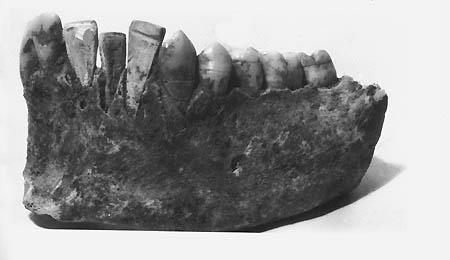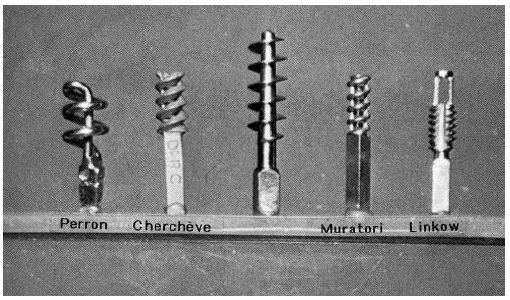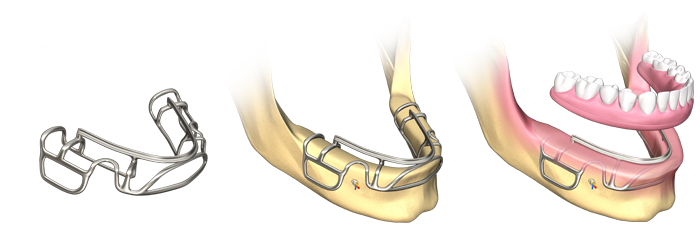The history of implantable technology. Dentures

Since prehistoric times, man has sought to replace teeth that have been lost as a result of injury or infection. The first materials that were used for this purpose were the fruit of human intellect and the foresight of nature. At the very first stage of development of dental implants, they were made from small stones or carved out of wood. Only many centuries later, in the era of developed industry, new methods and technologies were developed to replace missing human teeth.
Most of the efforts of the doctors were then aimed at rehabilitating partially or completely toothless patients. And only the appearance of intraosseous dental implants, such as we know them today, made it possible to solve this problem stretching for many centuries.
')
Antiquity
People used dental implants in one form or another to replace missing teeth from the very beginning of human history. Around 2500 BC. The ancient Egyptians tried to strengthen their decaying teeth with gold ligature wires. In addition, in the ancient manuscripts of the Egyptians, one can find several interesting references to caries, which for the first time identified him as a dental problem.
About 500 BC Etruscan tribes used the teeth of people and animals as prostheses and sealed holes in their teeth with the help of gold plates. They also made dentures from the bones of oxen. Around the same period, the Phoenicians used gold wire to strengthen the teeth, which were subjected to periodontitis. Around 300 AD these progressive peoples used carved ivory implants that were held together with gold wire to create a fixed bridge.

Golden "tire" that fixed Etruscan teeth
The first evidence of dental implants dates back to 600 AD. Then the Mayans greatly succeeded in using pieces of shells as prostheses to replace lower teeth. On radiographs of the lower jaws of the Maya, made in the 1970s, scientists found an increase in the solid bone tissue around the implants. It was very similar to how bone tissue builds up around the pin of modern dentures.

Maya implants
Middle Ages and Renaissance
In the period from the XVI to the XIX century in Europe, the problem of dentures was solved in a non-trivial way - the necessary teeth were simply removed from the jaws of the dead and replaced with those that were missing from the patient. In the 18th century, Dr. John Hunter collaborated with people who secretly abducted corpses from graves. With so much “material” for analysis, Hunter observed and described in detail the anatomy of the oral cavity and jaw.
Replacing teeth from one person to another is also his idea. Hunter's experiment involved implanting an underdeveloped tooth into bone. As a result of the experience, the tooth was firmly embedded in the bone and the blood vessels grew right in the pulp of the tooth.
XIX century
In the 19th century in Europe, damaged teeth were restored with the help of various substances - silver capsules, corrugated porcelain and iridium tubes. In 1806, Dr. Fonzie invented the mineral tooth - a discovery that is of great importance for the future development of implantology. His main achievement was the idea of making single artificial teeth that can be implanted directly into the “nest” with the help of platinum hooks that meet aesthetic and functional requirements, as well as chemically stable. The work of Fonzi influenced the work of his other contemporaries. In particular, the first attempt was made to create an intraosseous metal implant. In 1809, such an prosthesis was developed and implanted into the hole of a patient's extracted tooth by an Italian, Maggiolo.
XX century
1900-1930
Dr. EJ Greenfield (EJ Greenfield) in 1913 placed a hollow lattice cylinder of iridium-platinum alloy, soldered to 24-carat gold as an artificial root, which was placed in a circular incision in the patient's jaw bone. In the 1930s, the brothers Alvin and Moses Strock experimented with screws made from chromium-cobalt alloy. They watched doctors successfully place such implants in the femur, and began to independently carry out similar operations to restore individual teeth. Such pins consisted of fastening and support for replacing a lost tooth. The Strok Brothers received recognition for their work in successfully selecting a biocompatible metal that was used to replace teeth.

Greenfield implant
It is also believed that the Strok brothers were the first to successfully place the intraosseous implant. Dr. Alvin Strok worked not only with implant materials. He was also the first to use antibiotics in the treatment of periodontal infections, such as angina Vincent.
In 1938, Dr. P. B. Adams (PB Adams) patented a cylindrical intraosseous implant with a gingival cap and a gingham former that holds it in position.

Adams patent scheme
In the 40s, Formiggini and Zepponi’s “father of modern implantology” developed an endosseous implant in the form of a stainless steel spiral, allowing adhesion of bone and metal. Dr. Perron Andres (Spain) from Spain modified the spiral design of the Formigini dental prosthesis to include a solid shaft.

Spiral shapeigini
1940 - 1950
In the 1940s, some doctors began to pay attention to the development of subperiosteal (subperiosteal) implants. The first dental prosthesis, based on the bone tissue of the alveolar process, was suggested by the Swedish doctor Gustav Dahl. The idea of subperiosteal implantation is based on the strength of attachment of the periosteum collagen fibers to bone tissue, which are capable of ensuring the stability of the implant itself and the denture resting on it. In Sweden, the invention was greeted by the dental community with hostility, and in the USA, on the contrary, this idea found wide support and was recognized by many well-known experts.
This idea was developed by other doctors. So Gershkoff and Goldberg developed a cobalt-chromium-molybdenum implant with an improved Dahl design, to which was added an external oblique ridge. The subperiosteal prosthesis was further developed by Lew, Bausch, and Berman in 1950.
Throughout history, the main problem facing doctors was that flesh and bones rejected foreign bodies. For implantation to be successful, osteointegration is necessary - an anatomical and functional direct connection between the variable living bone and the implant surface, on which the main load falls. This means that in the process of chewing the implant directly affects the bone. In the absence of a tooth, the bone tissue atrophies due to insufficient load, and the installation of a denture solves this problem and stimulates its development, preventing destruction.
In 1952, the Swedish orthopedic surgeon Per-Ingvar Branemark accidentally discovered the special properties of titanium, which greatly increases the success of osteointegration. He was interested in studying bone healing and regeneration, and decided to implement a small optical chamber developed at Cambridge, which was surgically inserted into the rabbit tibial bone. The body of the optical camera was made of titanium.
During the study, he found out that the bone and the titanium cylinder had successfully grown together, so he continued his experiments on animals and humans. In 1965, the orthopedist, Brannemark, delivered the first titanium dental implant to a volunteer. This was a turning point in the history of dentistry: over the next decade, the implantation process was significantly improved.
1960-1980
An important step was the creation of Leonard Linkow self-tapping implants in 1964. Two years later, he also introduced an intraalveolar lobed implant of chromium, nickel, and vanadium. At that time, lobed-type implants were not recognized as clinically successful.

Dental implants in the 60-70s
In the 1970s, dentures acquired a familiar appearance. Of course, over the next decades, the original dental implant underwent a number of improvements in structure and design, but it was always based on the same principle.
In 1978, Dr. Brånemark introduced a two-stage titanium implant of the root form. He developed and tested a system using pure titanium screws, which were first placed in the jaws of his patients in 1965. This was the first documented case of the most successful implants that have been in place until now. The first patient of Brannemark had a serious deformation of the jaw and chin, as well as uneven teeth, some of which were missing altogether due to a congenital defect. Brånemark placed four implants in the lower jaw, which took root for the next six months and subsequently successfully served his master for another 40 years.
Two other innovators of implantology are Dr. Schroder (Shroder) and Dr. Straumann (Straumann). They experimented with metals used in orthopedic surgery to help make dental implants.
Since the mid-1980s, many physicians have used endosseous root form implants. The main factors that determine the advantage of the system of intraosseous implants were the design, the rough surface that promotes engraftment, the ease of insertion into the bone, the cost of their manufacture and their many years of success.
Modernity
Dental implants have proven to be a truly suitable replacement for missing teeth since the 1970s. However, it took several decades to make dental implants reliable. Researchers plunged deeper into dental implantology, focusing on the introduction of ceramic-like elements, such as zirconia, in the manufacture of dental prostheses. Researchers chose this material because of the proximity to titanium in the periodic table. In addition, zirconia has similar bio-compatibility properties with titanium. For the last 15 years crowns and dentures have been made from this material.
Modern dental implants consist of a rough screw made of titanium alloy. Surface roughness is necessary for successful osseointegration. This titanium screw is attached to the place in the jaw where the tooth used to be, and then the healing period follows. After the screw grows into the jaw, a crown is fastened on top of it. With proper care and oral hygiene, this method has high rates of success in the long term.
Implants of the new generation merge with the jaw, which ensures their natural and comfortable wearing. For successful installation of a denture, healthy gums, strong jaw bone and thorough oral hygiene are necessary.

Subperiosteal implants
In modern subperiosteal implants, a metal skeleton of a saddle shape is used, which is installed in the jaw bone directly under the gum tissue. The frame is attached to the jawbone when the gums heal. The posts attached to it protrude from the gums, and artificial teeth are already attached to them. Intraosseous implants are surgically implanted directly into the jaw bone. Once the tissue and gums surrounding the implant heal, an abutment and a crown are attached to it.
Implantology continues to evolve under the influence of technological capabilities. In 2015, researchers developed a process for creating implants and staples on a 3D printer. The creation of these implants is based on a material that kills almost 99% of all bacteria in the oral cavity. In its production, quaternary ammonium salts are used. Since they are positively charged, they destroy the negatively charged bacterial membranes, which causes them to die.
Source: https://habr.com/ru/post/401725/
All Articles